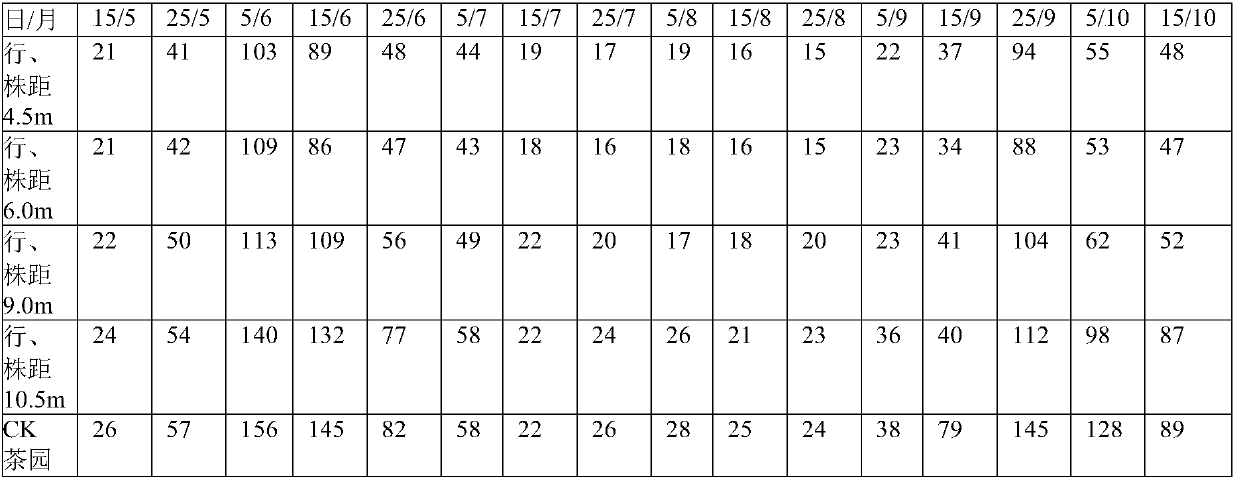Method for restricting tea garden empoasca vitis Gothe by intercropping Chinese chestnut trees
A technology of false-eyed small green leafhoppers and chestnut trees, applied in botany equipment and methods, horticulture, cultivation, etc., can solve the problems of excessive pesticide residues in finished tea leaves, drug resistance of leafhoppers, etc., reduce the number of times and doses, and protect the environment , Guarantee the effect of quality and safety
- Summary
- Abstract
- Description
- Claims
- Application Information
AI Technical Summary
Problems solved by technology
Method used
Image
Examples
example 1
[0010] Example 1 Attractive effect of chestnut leaves on the natural enemies of Leafhopper chrysalis
[0011] 1 Materials and methods
[0012] Using a Y-shaped olfactory instrument to measure the smell of chestnut leaves has a significant impact on the spiders that prey on the leafhopper (Three-protruded spider, white-spotted spider) and the parasitic wasps that parasitize the leafhopper's eggs (Leafhopper three-clawed wasp, micro-cracked wasp ) of the lure effect.
[0013] The base end of the Y-shaped olfactometer and the length of both arms are 10cm, and the angle between the two arms is 120°. The base is connected to an air pump for air extraction, and each arm is connected to a humidifier, a taste source bottle (or CK bottle), an activated carbon filter, and a flow meter in turn. Put fresh chestnut leaves in the flavor source bottle; the other arm is the CK arm, and no flavor source is placed in its CK bottle, that is, air is used as a control.
[0014] Pump air from th...
example 2
[0021] Example 2 Differences in the population of Leafhopper spp. in tea gardens with 4 kinds of chestnut intercropping densities
[0022] 1 Materials and methods
[0023] In the tea area of Songyang County, Zhejiang Province, several intercropping methods were selected in which the tea tree varieties were all Wuniuzao, and the distance between the bottom of the chestnut canopy and the tea canopy surface was 1.5m: ① chestnut row spacing 4.5m, plant spacing 4.5m; ② chestnut row spacing 6.0m, The row spacing of chestnuts is 6.0m; ③The chestnut row spacing is 9.0m, the row spacing is 9.0m; ④The chestnut row spacing is 10.5m, and the row spacing is 10.5m. The area of each tested tea garden is 10 mu.
[0024] From mid-May to mid-October in 2015, the population of Leafhopper with false eyes in tea gardens was investigated every ten days. Each survey was completed before 9:00 in the morning when the dew was still wet. In the tea garden of each intercropping method, 10 points w...
example 3
[0029] Example 3 Differences in the population of Leafhopper with false eyes in tea gardens with different distances from the surface of the tea canopy to the bottom of the chestnut tree canopy
[0030] 1 Materials and methods
[0031] In the tea plantation of Jingting Mountain in Xuancheng City, Anhui Province, the tea tree varieties are all Fuding Dabai tea, and the chestnut trees are intercropped in several ways in the tea garden with a row and plant spacing of 6.0m: ①The distance from the bottom of the chestnut crown to the canopy of the tea tree is 1.0m;② The distance is 1.5m; ③The distance is 2.0m; ④The chestnut is not intercropped in CK area. The area of each tested tea garden is 10 mu. From mid-May to mid-October in 2016, the population of Leafhopper with false eyes in tea gardens was investigated once every ten days, and the investigation method was the same as "Example 2".
[0032] 2 Results and Analysis
[0033] The results are shown in Table 3:
[0034] Table...
PUM
 Login to View More
Login to View More Abstract
Description
Claims
Application Information
 Login to View More
Login to View More - R&D
- Intellectual Property
- Life Sciences
- Materials
- Tech Scout
- Unparalleled Data Quality
- Higher Quality Content
- 60% Fewer Hallucinations
Browse by: Latest US Patents, China's latest patents, Technical Efficacy Thesaurus, Application Domain, Technology Topic, Popular Technical Reports.
© 2025 PatSnap. All rights reserved.Legal|Privacy policy|Modern Slavery Act Transparency Statement|Sitemap|About US| Contact US: help@patsnap.com



